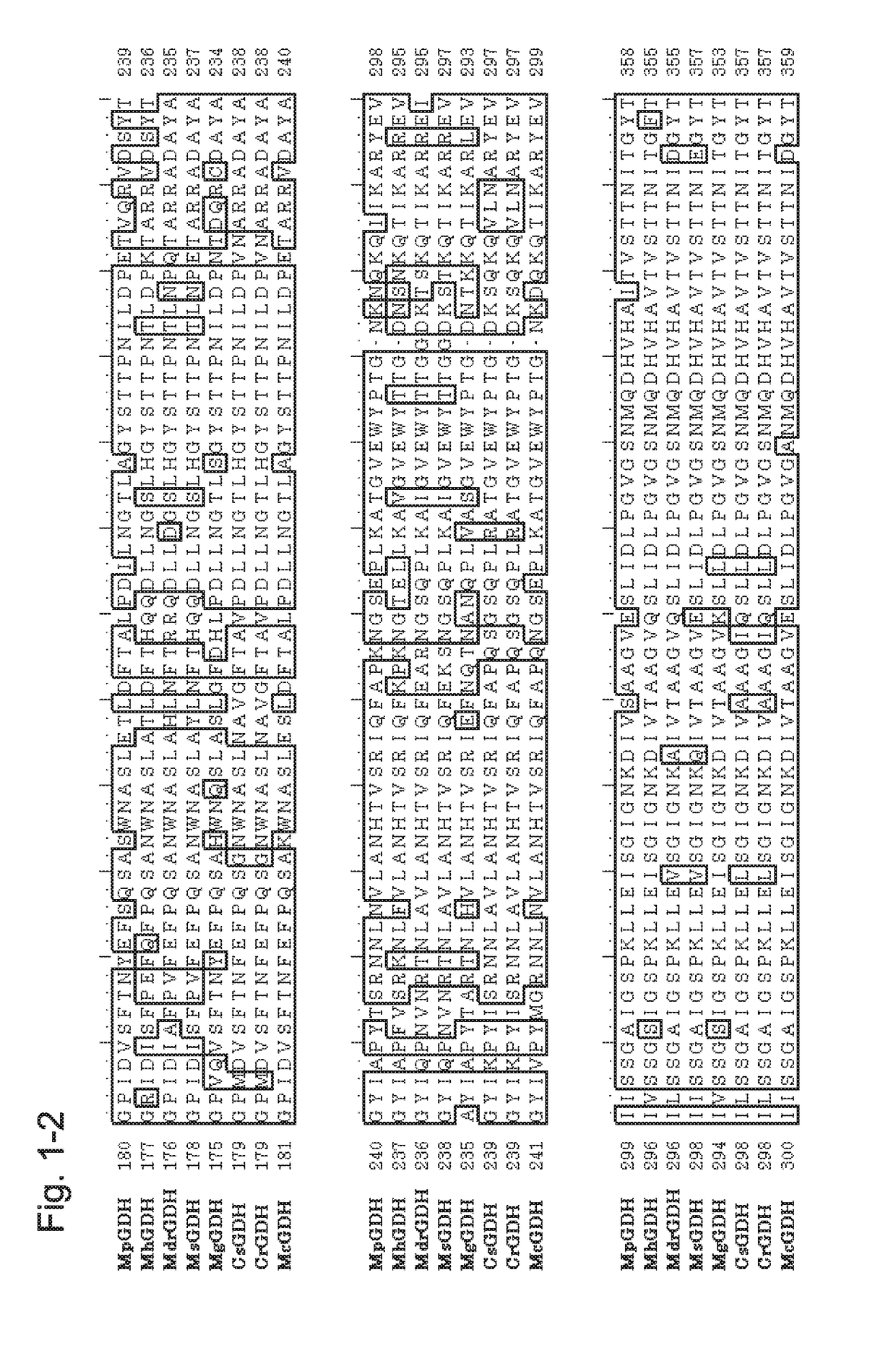Cytochrome-fused glucose dehydrogenase and glucose measurement method
a glucose dehydrogenase and glucose technology, applied in the field of glucose dehydrogenase and glucose measurement method, can solve the problems of difficult to immobilize a mediator onto an electrode surface, affecting measurement, and affecting the accuracy of glucose measurement, so as to achieve the effect of reducing the amount of mediators, improving accuracy, and low cos
- Summary
- Abstract
- Description
- Claims
- Application Information
AI Technical Summary
Benefits of technology
Problems solved by technology
Method used
Image
Examples
example 1
[0223]1. Introduction of the GDH Gene from the Genus Mucor Gene to a Host and Confirmation of GDH Activity
[0224]To the gene encoding a GDH from the genus Mucor (MpGDH, SEQ ID NO: 1), individual mutations of N66Y / N68G / C88A / Q233R / T387C / E554D / L557V / S559K were introduced to obtain a gene encoding a modified GDH (also referred to as MpGDH-M1 herein). The amino acid sequence of MpGDH-M1 is shown in SEQ ID NO: 10. The nucleotide sequence of the gene is shown in SEQ ID NO: 11. The target MpGDH-M1 gene was inserted into the multiple cloning site of plasmid pUC19 with routine methods to obtain a DNA construct. More specifically, as pUC19, the pUC19 linearized Vector provided with the In-Fusion HD Cloning Kit (Clontech) was used. To the In-Fusion Cloning Site present in the multiple cloning site of pUC19, the MpGDH-M1 gene was ligated by using the In-Fusion HD Cloning Kit mentioned above according to the protocol attached to the kit to obtain a plasmid construct (pUC19-MpGDH-M1).
[0225]SEQ ID N...
example 2
[0251]A gene encoding a GDH from Mucor RD056860 (MrdGDH) was obtained (see, WO 2013 / 118798). The amino acid sequence of MrdGDH is shown in SEQ ID NO: 4, and the nucleotide sequence of the gene of MrdGDH is shown in SEQ ID NO: 112.
[0252]In a manner similar to the Example above and by using In-Fusion HD Cloning Kit with the synthetic oligonucleotides of SEQ ID NOs: 130 to 133, the sequence of MtCytb and the linker sequence as shown in SEQ ID NO: 122 were inserted using pUC19-MrdGDH as the template to obtain the plasmid for the construct MtCytb-MrdGDH in which the cytochrome was fused to the N terminus of MrdGDH (pUC19-MtCytb-MrdGDH). Further, in a similar manner and by using the synthetic oligonucleotides of SEQ ID NOs: 134 to 137, the sequence of CtCytb and the linker sequence as shown in SEQ ID NO: 124 were inserted using pUC19-MrdGDH as the template to obtain the plasmid for the construct CtCytb-MrdGDH in which cytochrome was fused to the N terminus of MrdGDH (pUC19-CtCytb-MrdGDH)....
example 3
[0255]Onto a working electrode of SCREEN-PRINTED ELECTRODES (manufactured by DropSens, DRP-110) having a carbon working electrode of carbon and a silver reference electrode printed thereon, 875 μg of MtCytb-MpGDH-M1 was applied and dried at 37° C. Then, 25 μL of 3 wt % Agarose L (manufactured by Nippon Gene Co., Ltd.) dissolved at 37° C. was applied, and cooled at room temperature to embed and immobilize. Subsequently, the enzyme-immobilized printed electrode was connected as a working electrode to ALS electrochemical analyzer 814D (manufactured by BAS) by using a specific connector (manufactured by DropSens, DRP-CAC). Further, a saturated KCl silver / silver chloride reference electrode (manufactured by BAS) as a reference electrode, and a platinum electrode (manufactured by BAS) as a counter electrode were each connected to the ALS electrochemical analyzer 814D. The three electrodes were placed in 30 mL of 100 mM potassium phosphate solution (pH7.0). To this, 1M glucose was appropri...
PUM
| Property | Measurement | Unit |
|---|---|---|
| applied voltage | aaaaa | aaaaa |
| applied voltage | aaaaa | aaaaa |
| molecular weight | aaaaa | aaaaa |
Abstract
Description
Claims
Application Information
 Login to View More
Login to View More - R&D
- Intellectual Property
- Life Sciences
- Materials
- Tech Scout
- Unparalleled Data Quality
- Higher Quality Content
- 60% Fewer Hallucinations
Browse by: Latest US Patents, China's latest patents, Technical Efficacy Thesaurus, Application Domain, Technology Topic, Popular Technical Reports.
© 2025 PatSnap. All rights reserved.Legal|Privacy policy|Modern Slavery Act Transparency Statement|Sitemap|About US| Contact US: help@patsnap.com



